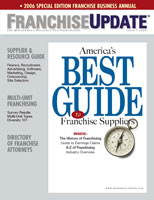Counting on Diversity
Chew on the numbers presented in this article and consider the implications for you and your organization from the perspective of your customers and employees--the people you hire and the people you sell to. You will see great numbers to keep in mind when positioning your company, looking for your next location, and developing your next marketing push.
Many of these numbers come from my work in the construction, landscaping, manufacturing, and related industries. These industries are in the trenches and understood their implications many years ago--and don't understand why so many other industries are not getting it. Consider the following facts, for example. In the United States:
- Net immigration is up significantly (no surprise here).
- Hispanics are the largest minority group in 14 of 24 states west of the Mississippi, as well as in Florida and all of the northeastern states, and are the largest U.S. minority overall.
- As a percentage of the total population, Hispanic residents are expected to double in number over the next half century, from 12 percent in 1999 to 24 percent in 2050 (crisis or opportunity?).
- Domestic migration (relocation within the U.S.) will continue to move populations to states in the South and West; five states that will experience the largest population increase are California, Texas, Florida, Washington, and Georgia.
More numbers to chew on: from 1990-2000 the growth of the foreign-born population in the United States was 57 percent, representing 13 percent of the total U.S. population. For selected states, the numbers are as follows:
Arkansas 196 percent
California 37 percent
Georgia 233 percent
North Carolina 274 percent
And consider these statistics in the labor market:
- In 1980, 82 percent of the U.S. workforce was white non-Hispanic; that number dropped to 73 percent in 2000, and is forecasted to fall to 53 percent by 2050.
- From 1996-2002, Hispanics made up 13 percent of the U.S. population, but supplied 51 percent of new workers.
- In Durham County, N.C., 67 percent of all construction workers are Hispanic; in Gwinnett County, Ga., 65 percent.
Waves
When you talk about Hispanic/Latino immigrants, you have to discuss the difference between immigrants, their children born in this country, and their children's children. So there are two waves to consider: immigrants and their children-and it's important to understand that religion and a tight-knit supportive extended family are crucial to this segment.
I am first-generation American (first in my family born in this country) with a foot in both worlds: while embracing the U.S. and American culture, I also want to honor my parents' heritage, culture, and roots. Here is what we know about Latinos like me:
- 12 million strong according to the U.S. Census Bureau
- In 2000, first-generation Americans (second-generation Latinos) accounted for 28 percent of the U.S. Latino population
Here is how those statistics are predicted to grow and change between 2000 and 2020:
- The number of U.S. Latinos born to immigrant parents will grow 119 percent (yes, 119 percent) and represent 36 percent of all U.S. Latinos (this compares with just 45 percent growth among immigrant Latinos)
- the Pew Hispanic Center predicts that the overall Latino population will increase 71 percent, while the white non-Hispanic population will increase only 14 percent.
As an aside, have you been noticing the bilingual signage, bank tellers and ATMs, telephone operators, telemarketers, and direct mail pieces in your mailbox? Oh wait, you may not be getting that literature or call! I do. But when a Spanish-speaking telemarketer calls my home I tell them I don't speak Spanish, and if the telemarketer is speaking English, I reply in Spanish (it does help to be bilingual). Reminds me of Freddie Prinze, Jr.'s, grandmother in his sitcom, who speaks only in Spanish, but seems to understand whatever is said in either language.
A call to action
So what are you going to do about it? I always say that demographic data does not lie, and that ignorance is not bliss. Demographics are destiny. The information in this article should be a call to action. If you don't have a bias for action after reading it, you deserve what's coming to you! Are you going turn aside and try to ignore what is happening right in front of you? We will see who is still standing in ten years--no, in five years.
Ignore the Hispanic/Latino influence in this country at your peril. Pretend you can continue to run your business the same way you always have and expect increasing returns. Hogwash! Get busy figuring out how to come out on top, how to see the opportunities upon us. Are you an entrepreneur or not?
Don't know how? One of the hottest jobs in 2006 may be your director of emerging markets, manager of diversity relations, coordinator of multicultural markets, or vice president of diversity and community relations. Call it whatever you want, but it will be a person who is part futurist and part change agent for your company.
- Study and embrace the emerging Hispanic/Latino labor force and marketplace in your industry space and get there first, because once your competition figures it out (and they will, if they haven't already) you'll be following. And you know that followers don't capture market share--they get the leftovers.
- Immerse yourself in everything Hispanic/Latino. Start watching Univision, Telemundo, or CNN Hispano. Join LULAC (The League of United Latin American Citizens), the National Council of La Raza, and the Hispanic Chamber of Commerce. Hire people with multicultural backgrounds. (They don't necessarily have to be Hispanic/Latino, but professionals who are multiculturally savvy, comfortable, and well versed in these emerging markets.)
- Pick up a Spanish newspaper, and please note that advertising on Spanish radio and newspapers is still a steal! Are you reading Hispanic Magazine, Latina, OYE or Tu Cuidad? Surf the web and go to Quepasa.com or MiGente.com.
- Hire bilingual staff and post the sign "Hablamos Español" and get ready to see what happens. Don't roll out your new Hispanic/Latino marketing and selling strategies in all your units or offices at once. Pilot it in one area or region and learn from your mistakes.
- Study and understand the influence of family, language, culture, and religion on the Hispanic/Latino experience. Come to grips with your own biases and preconceived notions. They may poison your understanding of the forces at play that will make or break your organization.
I close with a story of a best practices organization that I think is a glimpse into the future. I recently read an article about Wegmans Food Markets. I live near Washington Dulles Airport in the Herndon/Dulles area of northern Va., near Washington, D.C. This is an area where Hispanics/Latinos can make up as much as 40 to 70 percent of the population, depending on how you slice it. Our region has one of the lowest unemployment rates in the U.S.
At Wegmans in Dulles, more than 200 of 650 workers do not speak English as their primary language. The store offers its employees job training in English, Spanish, and Mandarin (think safety here!); courses in English as a second language; and a course in Spanish for managers. In addition, to help both workers and customers who don't speak English, Wegmans shows on its employees' name tags whether they speak a language other than English.
A spokesperson for Wegmans says, "Hiring immigrant workers makes good business sense, filling low-paying jobs that many U.S.-born workers don't want with employees motivated to move up through the ranks as they learn the language. Having a polyglot workforce can also boost sales and build loyalty among non-English-speaking customers."
By the way, my family loves Wegmans!
Mauricio Velasquez is president and CEO of The Diversity Training Group and Spanish Translation Services, LLC.
Share this Feature
Recommended Reading:
FRANCHISE TOPICS
- Multi-Unit Franchising
- Get Started in Franchising
- Franchise Growth
- Franchise Operations
- Open New Units
- Franchise Leadership
- Franchise Marketing
- Technology
- Franchise Law
- Franchise Awards
- Franchise Rankings
- Franchise Trends
- Franchise Development
- Featured Franchise Stories
FEATURED IN

Franchise Update Magazine: Issue 1, 2006








 The franchise listed above are not related to or endorsed by Franchise Update or Franchise Update Media Group. We are not engaged in, supporting, or endorsing any specific franchise, business opportunity, company or individual. No statement in this site is to be construed as a recommendation. We encourage prospective franchise buyers to perform extensive due diligence when considering a franchise opportunity.
The franchise listed above are not related to or endorsed by Franchise Update or Franchise Update Media Group. We are not engaged in, supporting, or endorsing any specific franchise, business opportunity, company or individual. No statement in this site is to be construed as a recommendation. We encourage prospective franchise buyers to perform extensive due diligence when considering a franchise opportunity.